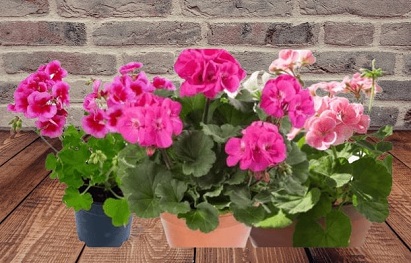Geraniums are popular houseplants that are widely kept in our apartments, office, terrace and gardens. Pelargonium belongs to the geranium family and grows in the wild in South Africa. It was brought to Europe at the end of the fifteenth century. Pelargonium is a direct relative of two geranium varieties: common geranium and meadow geranium. All flowers commonly grown at home are called “indoor geraniums” by botanists. The name geranium itself actually has Greek roots and translates as “crane” or “stork”. It gets its name from the resemblance of its fruit to a bird’s beak. Interestingly, the Germans call it the stork’s beak and the Americans and British have nicknamed it the cranesbill.
Can geranium flowers grow in pots in America?
Pelargoniums are useful flowers to keep at home and include annual and perennial herbaceous plants up to 60 centimeters tall. The leaf lamina of the crop has a tufted surface with a split structure, which is quite soft to the touch. Inflorescences are represented by several buds collected in groups of five. The petals can be velvety or plain, and their colors are red, lilac, white and blue. Pelargonium is a popular plant among gardeners due to its beautiful buds and long flowering period, as well as their persistence. Geraniums or pelargoniums have over a hundred different species. Among indoor geraniums, the most popular are red, white, fragrant, ampelina and royal geraniums. Someone who doesn’t like the smell of ordinary geranium might like the scented geranium, whose different varieties produce mint, nutmeg, lemon, apple and rose aromas.

Can geranium grow on the balcony in America?
The Latin name of geranium flower is Pelargonium zonale. Geranium Flower Features; The homeland of geranium flowers is South Africa. There are nearly 400 geranium varieties in nature. It is possible to say that the flower is perennial. It is a type of shrub that grows in herbaceous or semi-woody form. Colored geraniums can be tiered or single-tiered. Geraniums are balcony flowers.
How do you make the geranium plant bloom?
Geraniums can generally be considered an undemanding plant, but they have a number of requirements to consider. The large-flowered geranium is particularly fickle.
How to water the geranium flower? Geraniums grow well with regular watering. The main thing is not to overwater so that the soil is not flooded. Also avoid getting moisture on the foliage. It is best to water the plant with purified or just standing water, but rainwater can also do the job. During the rest period, the water should only be reduced by half. There is no need to moisturize the bush, as pelargonium loves dry air.
Do geraniums like sun or shade?
What you need to know about growing geraniums in America; Geraniums are extremely light-loving flowers. They are one of the few flowering houseplants that can be safely left in direct sunlight and will benefit even more from it. Low lighting makes the shrub sparse and poorly flowering. Gardeners recommend periodically rotating the pelargonium pot around its axis so that the bush develops more evenly. In late autumn and winter, when daylight hours are shortened, geraniums should be additionally illuminated with lamps, otherwise the leaves will begin to dull. Pelargoniums adapt very well to our room conditions. In summer the temperature can be between 20-25 °C and in winter between 10-15 °C. Keep the shrub away from drafts. Are geraniums native to America? Does geranium grow in US?
Does the geranium flower like humidity?

Dry air is also bad for the plant, but geraniums do not like spraying. A container of water or a special humidifier next to the plant is sufficient to ensure proper wintering care. Too dry air and high temperatures do not allow the geranium to regain its strength for the new season, and often, instead of a lush, bright bush, you will see pale green long branches that fail to bloom profusely in spring.
What are geranium plant pests?
Geraniums are susceptible to diseases such as black leg and rust. These are fungal diseases that are the result of improper care. Overwatering, stagnant water and the creation of a greenhouse effect contribute to the development of diseases. Removing damaged areas and providing the plants with optimal conditions for recovery can stop and eliminate the spread of the disease.
